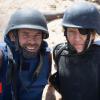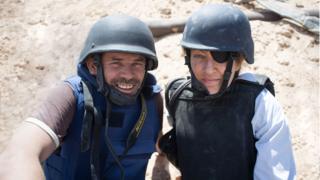 Image copyright Dogwoof Image caption Paul Conroy and the “notoriously difficult” Marie Colvin
Image copyright Dogwoof Image caption Paul Conroy and the “notoriously difficult” Marie Colvin
In 2012, in the besieged city of Homs, photojournalist Paul Conroy was lucky to escape alive when a makeshift media centre came under fire from Syrian government forces. His colleagues Marie Colvin and Remi Ochlik were killed. A new documentary Under the Wire tells the story – the first of two films this year to feature Colvin and Conroy.
Despite the violent way she died, there are times when Conroy can only smile at the memory of the war correspondent Colvin.
“I met Marie about 15 years ago. We were both trying to get into northern Iraq from Syria. I’d built a boat to cross the Tigris river out of lorry inner tubes and bits of wood and basically string.
“But I got captured and was sent back and in the journalists’ bar no one would speak to me because they all thought I’d spoiled their chances of getting in. Then Marie walked in and she said – who and where is the ‘Boatman’? I put my hand up and she said, ‘Boatman, can I buy you a whiskey?’ That was the start of it.”
After that Conroy bumped into the Sunday Times’ US-born correspondent several times. As a resourceful photo-journalist with a similar taste for the field of battle, he was aware of her reputation.
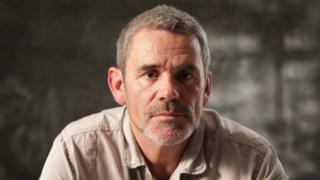 Image copyright Getty Images Image caption Paul Conroy was trusted by Marie Colvin
Image copyright Getty Images Image caption Paul Conroy was trusted by Marie Colvin
“She was notoriously difficult and some photographers she worked with found her scary. And she would just dump them if they didn’t fit.
“Marie and I worked together in Libya for the Sunday Times and once there was a guy who was to fill in for me for a couple of days. But almost at once Marie was on the phone saying get back here now – she’d already sent this guy off 300 miles and she never spoke to him again.”
Under the Wire, directed by film-maker Chris Martin, doesn’t try to portray Colvin as an easy colleague.
He remembers he was filming in the Caribbean when he heard of her death. “And I saw material on YouTube of Paul trapped in Syria. I saw that the people I was working with were really concerned about his fate and I knew at once there was a story to be told.”
Martin’s documentary shows what happens after Colvin and Conroy arrive in Homs through a 3km storm drain.
Conroy says the city was the obvious fulcrum of the story. The government of President Bashar al-Assad saw Homs as the major centre of revolt and was ready to crush dissent there.
 Image copyright Getty Images Image caption Edith Bouvier is flown home to France after escaping to Lebanon
Image copyright Getty Images Image caption Edith Bouvier is flown home to France after escaping to Lebanon
Conroy says just getting in was difficult. “We spent a week or two in Beirut making contacts. From there we went up into the mountains between Lebanon and Syria, where we met with members of the Free Syrian Army (a loose anti-Assad coalition). They took us over the border at night time through minefields, dodging army checkpoints. They then handed us over to another unit of the Free Syrian Army.
“It took about three days to go 30 kilometres. But the only way into Baba Amr – the part of Homs really getting hammered – was by this storm drain about 4ft high. We went through it bent double and carrying all our kit. We were pulled out of the tunnel, thrown in the back of a truck and ran the gauntlet of Syrian forces.
Conroy says the few journalists around Homs were aware of the risks. “I was told by a Lebanese source that Syrian government policy was to kill any journalists and then drop the bodies on the battlefield. It was a horrible situation and the film makes that very clear.”
Martin makes no apologies for having filled in pictorial gaps in the narrative. “We went to extraordinary lengths to find video material. A lot of it was just the odd five seconds taken in Homs by activists; it took a massive amount of tracking down, not just in the Middle East. We found things like a Skype call made from the journalists’ base in Homs at the moment the rockets hit.”
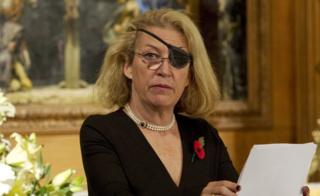 Image copyright Getty Images Image caption Marie Colvin at a service for journalists, cameramen and support staff to have died in war zones
Image copyright Getty Images Image caption Marie Colvin at a service for journalists, cameramen and support staff to have died in war zones
But he says some 15 minutes of the running time consists of reconstructions of what happened to Colville and Conroy and to the other four journalists with them before the fatal attack – Edith Bouvier, Remi Ochlik and William Daniels, who were all French, and the Spanish journalist Javier Espinosa.
Martin acknowledges this is not a the film like this might have been made only a few years ago.
“We had just three or four minutes of material which Paul had shot – everything else was destroyed when the rockets came in. But we did find some footage of the tunnel and even of Paul and Marie in Homs working on what turned out to be Marie’s last piece of journalism.
“So we pieced together that archive with our interview with Paul and with the testament of Edith Bouvier and William Daniels – and of Wael their brave translator. That was the spine of the film.”
But Martin says the documentary market is changing and as a result he decided he needed to shoot high-quality extra material to knit the story together.
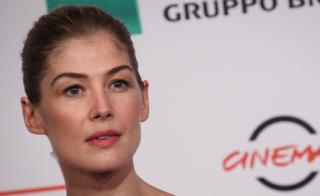 Image copyright Getty Images Image caption Rosamund Pike is to play Colvin in a feature film called a Private War
Image copyright Getty Images Image caption Rosamund Pike is to play Colvin in a feature film called a Private War
The production team decamped to northern Morocco to stage a version of the storm drain sequence. Additional interiors were shot in London. The craft skills on display mean the documentary often has the feel of a well-produced feature film.
“Documentaries like Under the Wire are now mainly going to be seen first on theatrical release,” he says. “They’re not just for TV. And if you’re in cinemas you’re competing with feature films which might cost $100m (£77m) or more. So we have to engage the viewer. We can’t expect audiences to come and find the story on our terms.”
The American director Matthew Heineman has also been at work on the life of Colvin. A Private War, which in part tells the same story, is due for release this year. But Heineman has made a feature film, starring Rosamund Pike as Colvin and with Jamie Dornan as Conroy.
In real life Conroy only realised back in London how badly he’d been hurt in the attack, which killed Colvin and Ochlik.
“Obviously I knew I had a huge hole in the back of my leg. But in London I found out I also had a great big piece of shrapnel wedged under my kidneys. I had 23 operations on my leg and others on my abdomen and back. I was in hospital for five months.
“There’s still a story to be told in Syria. I can’t even begin to say how deeply I regret Marie and Remi dying. But do I regret going in and trying to do our job? Absolutely not.”
Under the Wire is on release.

Follow us on Facebook, on Twitter @BBCNewsEnts, or on Instagram at bbcnewsents. If you have a story suggestion email entertainment.news@bbc.co.uk.
